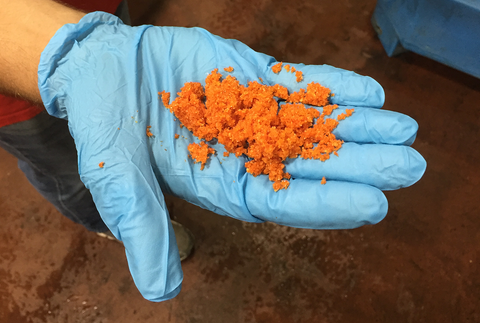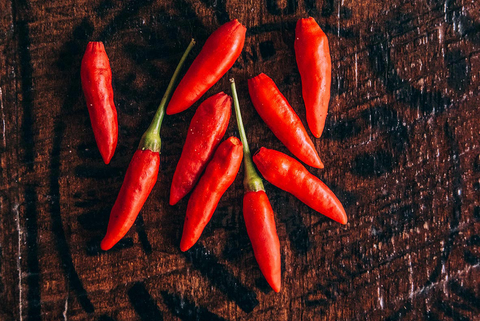How Tabasco's Hottest-Ever Sauce Is Made

I slide down my mask—the one I’ve been wearing to keep the cough-inducing vapor of aerosolized capsaicin out of my lungs—and examine the gleaming-red bits of scorpion pepper “mash” I hold on the pad of my index finger.
Pointing at the mash, one of Tabasco’s expert sauce-makers shakes his head and says, “That’s some fire right there.” He shakes his head some more and walks away from me—like he doesn’t approve of what I’m about to do.

ERICWOLFINGER
I’m standing on a poured-concrete floor in one of the sauce-making buildings on Tabasco’s campus, which is located on Avery Island, Louisiana—about two hours due west of New Orleans. Beside me and holding a scoop of the scorpion pepper mash is John Simmons, a sixth-generation member of the McIlhenny family that founded Tabasco on Avery Island back in 1868.
Simmons is in his late-30s, and he oversees agriculture and the making of small batch sauces for Tabasco. A few minutes earlier, I’d helped him and two other Tabasco employees load up the “liquiverter” and mill they use to make their new Scorpion Sauce—the hottest sauce Tabasco has ever produced. (And by “helped,” I mean I watched from a safe distance.)
Scorpion Sauce has 2 million Scoville units, exponentially hotter than original Tabasco
Scorpion Sauce checks in at roughly 2 million Scoville units—making it exponentially hotter than original Tabasco, which lands somewhere between 2,500 and 5,000 SHUs. Along with scorpion mash—which is chopped-up bits of Trinidad scorpion peppers mixed with salt—the sauce’s short list of ingredients includes guava and coarse-cut pineapple. Absent from the recipe is supplementary capsaicin—the natural irritant in hot peppers that gives them their mouth-charring burn.
“Anyone can do heat—anyone can do a basic sauce and then dial it up with raw capsaicin,” Simmons tells me. “What we want to do is use only the natural capsaicin from one of the hottest peppers on the planet and then use other natural ingredients to highlight the flavor of the scorpion pepper.”

Markham Heid
Back in the sauce-making room, I’d leaned over the tub of scorpion mash and briefly pulled back my mask to get a whiff. It had a sweet, tropical ambrosia that was both floral and fruity—the olfactory equivalent of a rainbow. It was easy to see why animals (and humans) would be tempted to eat these peppers, and why they would need to pack such insane amounts of natural fire to deter hungry mammals. (Simmons mentions that another member of the McIlhenny family—an elephant biologist in Africa—steered the company toward the scorpion pepper because he’d successfully used it to keep elephants from eating local crops.)
Now I watch Simmons dip a finger into the mash he’s holding. He lifts out a chunk about the same size as mine, and then he smiles at me. “You’re about to get the full sensory experience,” he says.
I’m not sure what I was expecting. Pain, mostly. But the first sensations are pleasurable. The mash is unexpectedly delicious—a salty flavor-bomb that tastes like the freshest exotic fruits in the world had been distilled down to their essences, mixed together, and dripped onto the tip and sides of my tongue. But the pleasure doesn’t last long.

Markham Heid
There’s that scene in Indiana Jones and the Last Crusade where the old dude drinks from what he thinks is the Holy Grail, but then realizes he was wrong and that he’s truly screwed. I’m sure my face looks exactly like that as the scorpion pepper starts to sink its fangs into my tongue.
“OK,” I say, my eyes beginning to water. “OK. OK.” The heat is growing more intense every second, and my throat and nostrils are suddenly burning as though I snorted battery acid.

Markham Heid
A full minute passes, and I feel like I’m riding a rollercoaster blindfolded; I have no idea when it’s going to stop climbing and make its descent. As if reading my mind, Simmons says, “I’m still accelerating.” I nod in agreement, but I’m afraid to talk because it might make things worse.
A few more seconds pass, and Simmons says some other stuff that I don’t catch because my brain and body are dealing with more pressing concerns. The burn is now searing, and my mouth is producing so much saliva that I feel like I could throw up. My eyes and nose are running, and I’m panting and gulping air even though it does nothing to help. It takes everything I have not to crouch down, hug my knees, and start drooling on the ground. I have delirium dreams of opening a gallon of milk and dumping it on my face.
But the minutes pass, and slowly I’m aware that the heat has plateaued. The burn gradually eases back—the pepper’s fangs slowly extricating themselves from my taste buds. In total, I’d eaten about a fingernail-shard’s worth of the scorpion mash.
Not ironically, Simmons asks me how I liked it. I get the sense he’s one of these guys who enjoys the heart rate-elevating burn of hot peppers. (He handled his bite of the mash with a lot more poise than I could muster.)
“In the beginning it was delicious,” I tell him. “I wasn’t expecting that.”
He nods in agreement, and then talks about his love of putting hot sauces on some unexpected (at least to me) foods. “My favorite is our habanero sauce with vanilla ice cream,” he says. “It’s also great with almost any fresh fruit—stuff like cantaloupe and pineapple.”

ERICWOLFINGER
Together we leave the building where Tabasco’s Scorpion Sauce and its other small-batch sauces are made and climb into Simmons’s pickup. As we drive toward another section of the company’s campus, I ask him how Tabasco was founded here on Avery Island, which is actually not an island at all but a massive salt dome carpeted with native flora. “Edmund McIlhenny was living out here with his in-laws, and we know he started selling the sauce commercially in 1868.”

Simmons says Edmund, his distant relative, had moved down to Avery Island from his native Maryland, and that he was “the 1860s version of a foodie.” But much about Edmund and Tabasco’s origin story remains cloaked in mystery. “We actually have an archivist and historian who has spent an enormous amount of time looking into it,” Simmons says. “But he’s unwilling to state much definitively until he can prove it, so we really don’t have much tamped down.”
A few minutes later we climb out of the truck and walk into a building Simmons calls “the barrel warehouse.” This is not a misnomer. Stepping inside the massive building, I see row after row of what look like whiskey barrels. There must be hundreds of them spread out on the central floor of the warehouse space, and stacked on either side of them are thousands more.

Tobasco
Simmons confirms that these are indeed repurposed whiskey barrels that are bought new and used to age the pepper mash used in Tabasco’s signature red sauce. Every drop of Tabasco sauce is made on Avery Island, he says, and every drop of it is made with peppers aged in barrels for three years. He has to repeat this a few times before I get it.
“Wait a minute,” I say.
“Every bottle of Tabasco I’ve had is barrel aged for three years?”
He laughs. “Not many people know that,” he says. “But that’s really the secret to Tabasco sauce.”
Considering the food-and-beverage industry’s current obsession with barrel-aging, I tell Simmons it’s shocking to me that Tabasco isn’t crowing about its barrel program in ads or on its famous label. He shrugs and says, “Talk to the marketing people about that—that’s not me.”

Tobasco
He uses a heavy mallet to remove the staves from two barrels—one containing young tabasco pepper mash, and the other three-year-aged mash. He notes that the young mash—apart from being a vibrant scarlet color, as opposed to the burnt appearance of the aged mash—has aromas of fresh-cut fruit like pears and apples. The aged mash smells of fermented dates, grapes, and preserves.
“How many barrels are here?” I ask him.
“Sixteen thousand, give or take,” he says. “And there are 48,000 in the big warehouse.”
There’s a bigger warehouse? We walk to an adjacent building that dwarfs the first. It’s stacked six-barrels high with aging pepper mash. “We have auditors come in from time to time that ask to see an individual barrel,” Simmons tells me. “Sometimes it’s way back in there, but they have to see it, so we have to take them in.” He laughs.
I ask if all these barrels contain mash for Tabasco’s red sauce. Simmons tells me no, there’s a mix here of the peppers used in all their sauces—from their green jalapeño sauce to their habanero sauce.

McIlhenny Company
Simmons and I spend some more time touring Tabasco’s facilities, including the bottling plant and the laboratory where each batch of sauce is tested to ensure its components are appropriately balanced. (When we stop by the lab, they’re about halfway through testing the scorpion sauce I watched Simmons and his coworkers make. So far it’s dead on.) Throughout my tour, we pause to chitchat with dozens of Tabasco employees, all of whom seem to know Simmons personally and are clearly proud of where they work and the sauces they make.

ERICWOLFINGER
Toward the end of my visit, I ask Simmons about the hot sauce business. I can’t get him to dish about any of Tabasco’s competitors, but he does hint that he thinks hot sauces are best when they don’t overpower foods. He says he likes a sauce that adds heat—something conspicuously absent from many so-called “hot sauces”—but that also heighten and complement the natural taste of foods without masking them.
Tabasco is celebrating its 150th anniversary this year. And to survive (and thrive) for a century and a half, the company has embraced innovation.
Along with its eight widely available sauces and its Scorpion Sauce, Tabasco is currently developing a handful of new offerings—a few of which I dribbled onto gumbo at Tabasco’s open-to-the-public restaurant on Avery Island. (One sauce in particular—a “roasted” sauce—was a smoky, complex stunner, and I urged Simmons to get that bad boy into grocery stores as soon as possible.)

Tobasco
But even many of Tabasco’s new offerings contain a bit of their original red sauce.
“You know, Tabasco red sauce is three things—it’s tabasco peppers, salt and vinegar,” Simmons says. He tells me this product’s simplicity and quality guide everything the company does.
“That’s our north star, and we always know where it points us,” he says.
Source: Read Full Article
